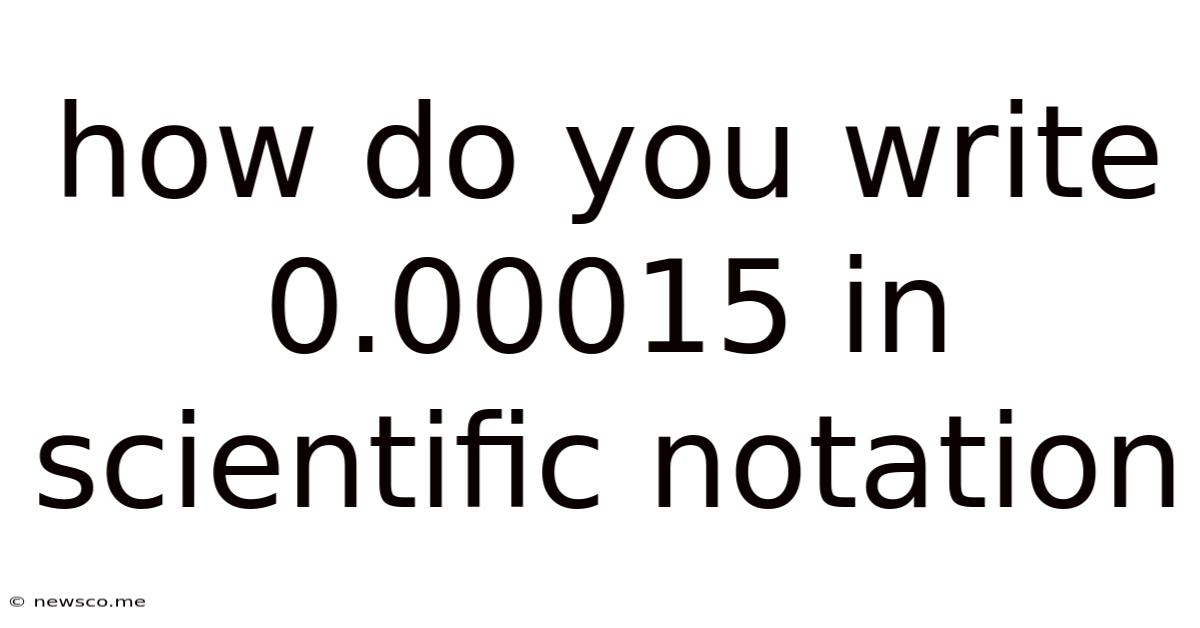How Do You Write 0.00015 In Scientific Notation
News Co
May 08, 2025 · 4 min read

Table of Contents
How Do You Write 0.00015 in Scientific Notation? A Comprehensive Guide
Scientific notation is a powerful tool used to represent very large or very small numbers concisely. It simplifies calculations and improves readability, especially when dealing with numbers encountered in fields like science, engineering, and finance. Understanding how to convert numbers like 0.00015 into scientific notation is crucial for anyone working with such values. This comprehensive guide will not only show you how to write 0.00015 in scientific notation but will also delve into the underlying principles and offer practical examples to solidify your understanding.
Understanding Scientific Notation
Scientific notation expresses a number as a product of two parts: a coefficient and a power of 10. The coefficient is a number between 1 and 10 (but not including 10), and the exponent represents the power of 10. The general form is:
a x 10<sup>b</sup>
where:
- a is the coefficient (1 ≤ a < 10)
- b is the exponent (an integer)
For instance, the number 6,500,000 can be written in scientific notation as 6.5 x 10<sup>6</sup>. Here, 6.5 is the coefficient, and 6 is the exponent. This signifies that we move the decimal point six places to the right to obtain the original number.
Converting 0.00015 to Scientific Notation: A Step-by-Step Approach
To convert 0.00015 into scientific notation, we follow these steps:
-
Identify the coefficient: We need to rewrite 0.00015 so that it's a number between 1 and 10. In this case, that number is 1.5.
-
Determine the exponent: We count the number of places the decimal point needs to be moved to achieve the coefficient (1.5). In 0.00015, the decimal point must be moved four places to the right to obtain 1.5. Since we moved the decimal point to the right, the exponent will be negative.
-
Write the scientific notation: Combining the coefficient and exponent, we get:
1.5 x 10<sup>-4</sup>
Therefore, 0.00015 in scientific notation is 1.5 x 10<sup>-4</sup>.
Why Use Negative Exponents?
The negative exponent in this case signifies that the original number is less than 1. A negative exponent indicates that we need to move the decimal point to the left to obtain the original number. The magnitude of the negative exponent corresponds to the number of places we move the decimal to the left.
For example:
- 10<sup>-1</sup> = 0.1 (decimal point moved one place to the left)
- 10<sup>-2</sup> = 0.01 (decimal point moved two places to the left)
- 10<sup>-3</sup> = 0.001 (decimal point moved three places to the left)
- And so on...
Practical Applications and Examples
Scientific notation is widely used in various fields:
1. Physics and Chemistry:
Imagine calculating the mass of an electron, which is approximately 0.00000000000000000000000000091 kg. Using scientific notation, we express this as 9.1 x 10<sup>-31</sup> kg. This is much more manageable and less prone to errors than using the original number.
2. Astronomy:
Distances in space are vast. For instance, the distance to the Andromeda galaxy is approximately 24,000,000,000,000,000,000 kilometers. Scientific notation expresses this as 2.4 x 10<sup>22</sup> kilometers, simplifying calculations involving these enormous distances.
3. Biology:
In microbiology, dealing with microscopic organisms requires expressing their sizes in scientific notation. For example, the diameter of a bacterium might be 0.000001 meters, which can be written as 1 x 10<sup>-6</sup> meters (or 1 micrometer).
4. Finance:
While less common than in scientific disciplines, scientific notation can help represent extremely large or small financial values, particularly in contexts involving national debt, global markets, or microtransactions.
More Examples of Scientific Notation Conversion
Let's practice with a few more examples:
-
0.0000056: Move the decimal point five places to the right to get 5.6. The exponent is -5. Therefore, the scientific notation is 5.6 x 10<sup>-5</sup>.
-
0.00234: Move the decimal point three places to the right to get 2.34. The exponent is -3. The scientific notation is 2.34 x 10<sup>-3</sup>.
-
0.000000789: Move the decimal point seven places to the right to get 7.89. The exponent is -7. The scientific notation is 7.89 x 10<sup>-7</sup>.
-
876,500: Move the decimal point five places to the left to get 8.765. The exponent is 5. The scientific notation is 8.765 x 10<sup>5</sup>.
Mastering Scientific Notation: Tips and Tricks
-
Practice regularly: The key to mastering scientific notation is consistent practice. Try converting various numbers—both large and small—into scientific notation.
-
Visualize the decimal point movement: Imagine the decimal point moving to help you determine the exponent.
-
Use online calculators and converters: Many online tools can help you check your work and improve your understanding.
Conclusion
Converting numbers like 0.00015 to scientific notation (1.5 x 10<sup>-4</sup>) involves understanding the basic principles and applying a systematic approach. This concise representation offers significant advantages in various fields, particularly when dealing with extremely large or small numbers. By mastering this skill, you’ll enhance your ability to handle numerical data effectively and improve your understanding of scientific and mathematical concepts. Remember to practice regularly and use available resources to refine your skills and build a strong foundation in scientific notation.
Latest Posts
Latest Posts
-
Factors Of 225 That Add Up To 30
May 08, 2025
-
Which Of The Following Is Not A Polynomial Identity
May 08, 2025
-
12 5 Percent As A Fraction In Simplest Form
May 08, 2025
-
What Is 17 Pounds In Dollars
May 08, 2025
-
Convert 70 British Pounds To Dollars
May 08, 2025
Related Post
Thank you for visiting our website which covers about How Do You Write 0.00015 In Scientific Notation . We hope the information provided has been useful to you. Feel free to contact us if you have any questions or need further assistance. See you next time and don't miss to bookmark.